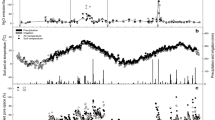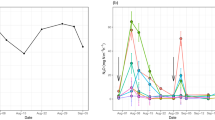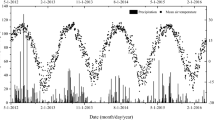Abstract
The aim of this study was to evaluate the effectiveness of nitrification inhibitor (nitrapyrin; NI) as a mitigation option for yield-scaled emissions of nitrous oxide (N2O) under tillage management and urea fertilization in the irrigated maize fields in northern Iran. A split-plot experiment was performed based on a randomized completed blocks design with three replicates. The main plots were the levels of tillage practices (conventional tillage (CT) and minimum tillage (MT), and the subplots were the fertilizer treatments (control, urea, and urea + NI). The gas samples for measuring N2O emissions were collected during the maize growing season from June to September, using opaque manual circular static chambers. Soil samples were taken at 0–10 cm to determine water-filled pore space, ammonium (NH4+), and nitrate (NO3−) concentrations in the soil. When the crop reached physiological maturity, maize was harvested to measure grain yield, biomass production, N uptake of aboveground, and nitrogen use efficiency (NUE). The results showed that the applying NI in combination with urea reduced the total N2O emissions by up to 58% and 64% in MT and CT, respectively. In the urea + NI treatment, mean soil concentrations of NH4+ and NO3− were significantly higher (20%) and lower (23.5%), respectively, compared with other treatments. The NI reduced the yield-scaled N2O–N emission up to 79% and 55% for CT and MT, respectively. Furthermore, compared to treatment with urea alone, the application of NI increased the NUE of the MT and CT systems by an average of 55% and 46%, respectively. This study emphasized that the application of nitrapyrin should be encouraged in irrigated maize fields, in order to minimize N2O emissions and improve NUE and biomass production.



Similar content being viewed by others
Data availability
The datasets used and/or analyzed during the current study are available from the corresponding author on reasonable request.
References
Bayer C, Gomes J, Zanatta JA, Vieira FCB, de Cássia PM, Dieckow J, Six J (2015) Soil nitrous oxide emissions as affected by long-term tillage, cropping systems and nitrogen fertilization in Southern Brazil. Soil Tillage Res 146:213–222
Bell M, Hinton N, Cloy J, Topp C, Rees R, Cardenas L, Scott T, Webster C, Ashton R, Whitmore A (2015) Nitrous oxide emissions from fertilised UK arable soils: fluxes, emission factors and mitigation. Agric Ecosyst Environ 212:134–147
Borzouei A, Mander U, Teemusk A, Alberto SC, Zaman M, Dong-Gill K, Muller C, Askary Kelestanie A, Sayyad Amin P, Moghiseh E, Dawar K, Pérez-Castillo A (2021) Effects of the nitrification inhibitor nitrapyrin and tillage practices on yield-scaled nitrous oxide emission from a maize field in Iran. Pedosphere 31:314–322
Chen D, Suter HC, Islam A, Edis R (2010) Influence of nitrification inhibitors on nitrification and nitrous oxide (N2O) emission from a clay loam soil fertilized with urea. Soil Biol Biochem 42:660–664
Dawar K, Sardar K, Zaman M, Mueller C, Sanz-Cobena A, Khan A, Borzouei A, Pérez-Castillo AG (2021) Effects of the nitrification inhibitor nitrapyrin and the plant growth regulator gibberellic acid on yield-scale nitrous oxide emission in maize fields under hot climatic conditions. Pedosphere 31:323–331
Ding WX, Hongyan YY, Cai ZC (2011) Impact of urease and nitrification inhibitors on nitrous oxide emissions from fluvo-aquic soil in the North China Plain. Biol Fertil Soils 47:91–99
Elmi A, Mehdi B, Chandra M, Dam R, Smith D (2009)Long-term effect of conventional and no-tillage production systems on nitrous oxide fluxes from corn (Zea mays L.) field in Southwestern Quebec. Am J Environ Sci 5:238–246
FAO (Food and Agriculture Organization). (2014). Statistics of production: crops, available online at: http://faostat3. fao.org/browse/Q/QC/E.
Fisk L, Maccarone L, Barton L, Murphy D (2015) Nitrapyrin decreased nitrification of nitrogen released from soil organic matter but not amoA gene abundance at high soil temperature. Soil Biol Biochem 88:214–223
Friedl J, Scheer C, Rowlings DW, Mumford MT, Grace PR (2017) The nitrification inhibitor DMPP (3,4-dimethylpyrazole phosphate) reduces N2 emissions from intensively managed pastures in subtropical Australia. Soil Biol Biochem 108:55–64
Guardia G, Cangani MT, Andreu G, Sanz-Cobena A, García-Marco S, Álvarez JM, Recio-Huetos J, Vallejo A (2017) Effect of inhibitors and fertigation strategies on GHG emissions, NO fluxes and yield in irrigated maize. Field Crop Res 204:135–145
Halvorson AD, Del Grosso SJ, Reule CA (2008) Nitrogen, tillage, and crop rotation effects on nitrous oxide emissions from irrigated cropping practices. J Environ Qual 37:1337–1344
Hu Y, Schraml M, Von Tucher S, Li F, Schmidhalter U (2014) Influence of nitrification inhibitors on yields of arable crops: a meta-analysis of recent studies in Germany. Int J Plant Prod 8:33–50
Järveoja J, Peichl M, Maddison M, Soosaar K, Vellak K, Karofeld E, Teemusk A, Mander Ü (2016) Impact of water table level on annual carbon and greenhouse gas balances of a restored peat extraction area. Biogeosciences 13:2637–2651
Li B, Fan C, Xiong Z, Li Q, Zhang M (2015) The combined effects of nitrification inhibitor and biochar incorporation on yield-scaled N2O emissions from an intensively managed vegetable field in southeastern China. Biogeosciences 12:2003–2017
Liu X, Mosier A, Halvorson A, Zhang F (2005) Tillage and nitrogen application effects on nitrous and nitric oxide emissions from irrigated corn fields. Plant Soil 276:235–249
Liu C, Wang K, Zheng X (2013) Effects of nitrification inhibitors (DCD and DMPP) on nitrous oxide emission, crop yield and nitrogen uptake in a wheat–maize cropping system. Biogeosciences 10:2427–2437
Lynch JM, Barbano DM (1999) Kjeldahl nitrogen analysis as a reference method for protein determination in dairy products. J AOAC Int 82:1389–1398
Menéndez S, Barrena I, Setien I, González-Murua C, Estavillo JM (2012) Efficiency of nitrification inhibitor DMPP to reduce nitrous oxide emissions under different temperature and moisture conditions. Soil Biol Biochem 53:82–89
Meteorology department of Karaj (2013): Report of General Meteorological Alborz. I. R. of Iran Meteorological Organization. Available online at http://www.karajmet.ir/Eghlimi.com (verified on February 2, 2018).
Müller C, Sherlock RR (2004) Nitrous oxide emissions from temperate grassland ecosystems in the Northern and Southern Hemispheres. Glob Biogeochem Cycles 18
Ngoma H, Mason NM, Sitko NJ (2015) Does minimum tillage with planting basins or ripping raise maize yields? Meso-panel data evidence from Zambia. Agric Ecosyst Environ 212:21–29
Pasda G, Hähndel R, Zerulla W (2001) Effect of fertilizers with the new nitrification inhibitor DMPP (3,4-dimethylpyrazole phosphate) on yield and quality of agricultural and horticultural crops. Biol Fertil Soils 34:85–97
Pelster DE, Larouche F, Rochette P, Chantigny MH, Allaire S, Angers DA (2011) Nitrogen fertilization but not soil tillage affects nitrous oxide emissions from a clay loam soil under a maize–soybean rotation. Soil Tillage Res 115:16–26
Pengthamkeerati P, Modtad A (2016) Nitrification inhibitor, fertilizer rate, and temperature effects on nitrous oxide emission and nitrogen transformation in loamy sand soil. Commun Soil Sci Plant Anal 47:425–432
Pilegaard K (2013) Processes regulating nitric oxide emissions from soils. Philos Trans R Soc B: Biol Sci 368:20130126
Plaza-Bonilla D, Álvaro-Fuentes J, Arrúe JL, Cantero-Martínez C (2014) Tillage and nitrogen fertilization effects on nitrous oxide yield-scaled emissions in a rainfed Mediterranean area. Agric Ecosyst Environ 189:43–52
Rashti MR, Wang W, Moody P, Chen C, Ghadiri H (2015)Fertiliser-induced nitrous oxide emissions from vegetable production in the world and the regulating factors: a review. Atmos Environ 112:225–233
Sanz-Cobena A, Sánchez-Martín L, García-Torres L, Vallejo A (2012) Gaseous emissions of N2O and NO and NO3− leaching from urea applied with urease and nitrification inhibitors to a maize (Zea mays) crop. Agric Ecosyst Environ 149:64–73
Sanz-Cobena A, García-Marco S, Quemada M, Gabriel J, Almendros P, Vallejo A (2014) Do cover crops enhance N2O, CO2 or CH4 emissions from soil in Mediterranean arable systems? Sci Total Environ 466:164–174
Shang Z, Abdalla M, Kuhnert M, Albanito F, Zhou F, Xia L, Smith P (2020) Measurement of N2O emissions over the whole year is necessary for estimating reliable emission factors. Environ Pollut 259:113864
Slangen JHG, Kerkhoff P (1984) Nitrification inhibitors in agriculture and horticulture: a literature review. Fertil Res 5:1e76
Smith P, Goulding KW, Smith KA, Powlson DS, Smith JU, Falloon P, Coleman K (2001) Enhancing the carbon sink in European agricultural soils: including trace gas fluxes in estimates of carbon mitigation potential. Nutr Cycl Agroecosyst 60:237–252
Statistical Analysis System (SAS) Institute (2004)SAS/STAT User’s Guide. Version 9.1. Cary, SAS Institute Inc. North Carolina, USA
Thierfelder C, Chivenge P, Mupangwa W, Rosenstock TS, Lamanna C, Eyre JX (2017) How climate-smart is conservation agriculture (CA)?–Its potential to deliver on adaptation, mitigation and productivity on small holder farms in southern Africa. Food Sec 9:537–560
Umar BB, Aune JB, Johnsen FH, Lungu OI (2011) Options for improving small holder conservation agriculture in Zambia. J Agric Sci 3:50
Van Groenigen JW, Velthof G, Oenema O, Van Groenigen KJ, Van Kessel C (2010) Towards an agronomic assessment of N2O emissions: a case study for arable crops. Eur J Soil Sci 61:903–913
Venterea RT, Maharjan B, Dolan MS (2011) Fertilizer source and tillage effects on yield-scaled nitrous oxide emissions in a corn cropping system. J Environ Qual 40:1521–1531
Villar Mir JM, Guillaumes Cullell E (2010) Use of nitrification inhibitor DMPP to improve nitrogen recovery in irrigated wheat on a calcareous soil. Span J Agric Res 8:1218–1230
Zhang X, Davidson EA, Mauzerall DL, Searchinger TD, Dumas P, Shen Y (2015) Managing nitrogen for sustainable development. Nature 528:51e59–51e59
Zhao D, Glaz B, Comstock JC (2014) Physiological and growth responses of sugarcane genotypes to nitrogen rate on a sand soil. J Agron Crop Sci 200:290–301
Acknowledgements
This work was funded by the International Atomic Energy Agency, Vienna, through the coordinated research project Minimizing Farming Impacts on Climate Change by Enhancing Carbon and Nitrogen Capture and Storage in Agro-Ecosystems (No. 18595) of Soil and Water Management and Crop Nutrition Section, Joint FAO/IAEA Division of Nuclear Techniques in Food and Agriculture, Department of Nuclear Sciences and Applications, Vienna, Austria.
Funding
This work was funded by the International Atomic Energy Agency, Vienna.
Author information
Authors and Affiliations
Contributions
AB carried out the experiment, performed the data analyses, and wrote the manuscript. CM and KD designed the research, provided all the technical support during the laboratory work, and wrote the manuscript. CM, MZ, and DK helped in the design of the experiment. CM and AS measured the gas data. AS and SS revised and corrected the draft manuscript. All authors commented on previous versions of the manuscript, and all authors read and approved the final manuscript.
Corresponding author
Ethics declarations
Ethics approval and consent to participate
The authors declare that they have no known competing financial interests or personal relationships that seem to affect the work reported in this article.
Consent for publication
We do not have any individual person’s data in any form.
Competing interests
The authors declare no competing interests.
Additional information
Responsible Editor: Philippe Garrigues
Publisher’s note
Springer Nature remains neutral with regard to jurisdictional claims in published maps and institutional affiliations.
Supplementary Information
ESM 1
(DOCX 527 kb)
Rights and permissions
About this article
Cite this article
Borzouei, A., Saadati, S., Müller, C. et al. Reducing nitrous oxide emissions from irrigated maize by using urea fertilizer in combination with nitrapyrin under different tillage methods. Environ Sci Pollut Res 29, 14846–14855 (2022). https://doi.org/10.1007/s11356-021-16768-0
Received:
Accepted:
Published:
Issue Date:
DOI: https://doi.org/10.1007/s11356-021-16768-0




